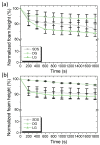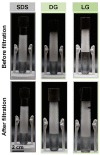Decontamination of Spores on Model Stainless-Steel Surface by Using Foams Based on Alkyl Polyglucosides
- PMID: 36770605
- PMCID: PMC9919089
- DOI: 10.3390/molecules28030936
Decontamination of Spores on Model Stainless-Steel Surface by Using Foams Based on Alkyl Polyglucosides
Abstract
In the food industry, the surfaces of processing equipment are considered to be major factors in the risk of food contamination. The cleaning process of solid surfaces is essential, but it requires a significant amount of water and chemicals. Herein, we report the use of foam flows based on alkyl polyglucosides (APGs) to remove spores of Bacillus subtilis on stainless-steel surfaces as the model-contaminated surface. Sodium dodecyl sulfate (SDS) was also studied as an anionic surfactant. Foams were characterized during flows by measuring the foam stability and the bubble size. The efficiency of spores' removal was assessed by enumerations. We showed that foams based on APGs could remove efficiently the spores from the surfaces, but slightly less than foams based on SDS due to an effect of SDS itself on spores removal. The destabilization of the foams at the end of the process and the recovery of surfactant solutions were also evaluated by using filtration. Following a life cycle assessment (LCA) approach, we evaluated the impact of the foam flow on the global environmental footprint of the process. We showed significant environmental impact benefits with a reduction in water and energy consumption for foam cleaning. APGs are a good choice as surfactants as they decrease further the environmental impacts.
Keywords: cleaning; foam; life cycle analysis; spore; surface hygiene.
Conflict of interest statement
The authors declare no conflict of interest.
Figures









References
-
- Faille C., Cunault C., Dubois T., Benezech T. Hygienic Design of Food Processing Lines to Mitigate the Risk of Bacterial Food Contamination with Respect to Environmental Concerns. Innov. Food Sci. Emerg. Technol. 2018;46:65–73. doi: 10.1016/j.ifset.2017.10.002. - DOI
-
- González-Rivas F., Ripolles-Avila C., Fontecha-Umaña F., Ríos-Castillo A.G., Rodríguez-Jerez J.J. Biofilms in the Spotlight: Detection, Quantification, and Removal Methods: Biofilms DQR in the Food Industry…. Compr. Rev. Food Sci. Food Saf. 2018;17:1261–1276. doi: 10.1111/1541-4337.12378. - DOI - PubMed
-
- Deleplace M., Dallagi H., Dubois T., Richard E., Ipatova A., Bénézech T., Faille C. Structure of Deposits Formed by Drying of Droplets Contaminated with Bacillus Spores Determines Their Resistance to Rinsing and Cleaning. J. Food Eng. 2022;318:110873. doi: 10.1016/j.jfoodeng.2021.110873. - DOI
-
- Tsai J.-H., Huang J.-Y., Wilson D.I. Life Cycle Assessment of Cleaning-in-Place Operations in Egg Yolk Powder Production. J. Clean. Prod. 2021;278:123936. doi: 10.1016/j.jclepro.2020.123936. - DOI
LinkOut - more resources
Full Text Sources
Research Materials

